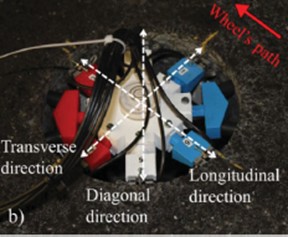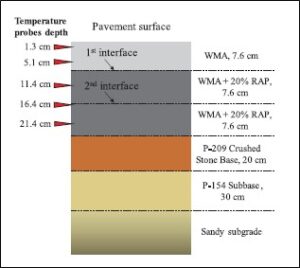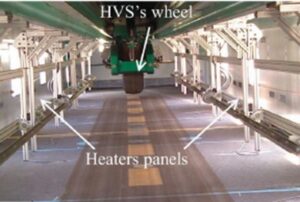24/03/2025
Application of Heavy Vehicle Simulator (HVS) in Ovalisation Test Analysis
The Heavy Vehicle Simulator (HVS) is a customizable device built by Dynatest to study the performance of asphalt mixes and other pavement materials at very high tire pressures and loads. A loaded wheel trafficked either unidirectionally or bidirectionally within the machine, simulating the passage of heavy vehicles or aircraft.
With its automatic heating/cooling system, it can maintain a stable temperature throughout the test and the HVS allows for adjustment of wheel load, speed, offset, and much more. With this introduction, it is clear that the HVS can be used for a wide variety of testing procedures.
The following pages discuss a study conducted with the HVS on the ovalisation test.
The original article is titled “Experimental and Numerical Study on Ovalisation Test for Pavement and HMA Layer Interface Behaviour Assessment,” written by Victor Resenterra, Jean-Marie Roussel, Navneet Garg, Michaël Broutin, and Lucy Travailleur.
Assessing pavement layer interfaces is crucial for predicting pavement lifespan.
The bonding conditions between layers significantly influence the performance and durability of multi-layered pavements, particularly in relation to stress concentration. When subjected to traffic loads, pavements can be analyzed as a beam on simple supports, experiencing compressive stress on the surface and tensile stress at the base. Proper bonding ensures mechanical efficiency, with tensile stress localized at the base of asphalt layers. Conversely, poor bonding, such as debonding or sliding interfaces, results in increased stress and strain, accelerating cracking.
However, such damage mechanisms are often neglected in conventional pavement design methodologies, even though real-world interface testing often reveals partially bonded scenarios.
Testing interface conditions in situ remains limited. Coring the pavement allows for measuring layer thickness and inspecting interface quality. However, this test can be biased because the interface observed after extraction may get damaged during the coring procedure.
Other methods, such as tensile adhesion tests and the torque bond test, are conducted directly on the road surface to assess the strength of the interface closest to the surface layer of the structure, but they show significant levels of variability.
The ovalisation test, first invented by the Laboratoire Régional des Ponts et Chaussées (LRPC) in St-Brieuc, France, enables the assessment of interface bonding conditions.
It involves coring a circular hole and inserting the ovalisation device (see figure below), which is equipped with sensors to measure diameter variations in the longitudinal, transverse, and diagonal directions.

These measurements at different depths, taken above and below the interface, reveal bonding conditions.
Subsequent versions of the device have enhanced usability and integration with dynamic impulse loading devices like the Heavy Weight Deflectometer. This allows testing under conditions resembling actual traffic, with deflection data aiding in identifying delaminated interfaces.
Efforts are ongoing to incorporate ovalisation testing into structural diagnostic practices, and the latest study was conducted using the Dynatest Heavy Vehicle Simulator-Airfield (HVS-A). These investigations aim to evaluate the impact of variables such as load, speed, offset, and temperature on test outcomes.
The pavement studied, depicted in the accompanying figure, is a flexible airport pavement comprising six layers. It includes a 7.6 cm-thick wearing course of Warm Mix Asphalt (WMA), underlain by a 7.6 cm-thick layer of WMA containing 20% recycled asphalt pavement (WMA+20% RAP). A second layer of the same composition and thickness follows.
The base layer consists of crushed stone material (P-209), while the sub-base layer is designated as P-104, in accordance with FAA specifications. The upper subgrade is primarily composed of sand.

Temperature probes were installed within the pavement to measure the temperature profile at five different depths. A bituminous binder, applied as a tack coat between layers, enhances interlayer bonding and stiffness. The interfaces under study involve the top three pavement layers.
A core hole was created in the test section by extracting a full-depth asphalt core down to the granular base layer (P-209). The ovalisation device was installed sequentially at five depths within this core hole: at the core hole surface, as well as above and below each interface.
The Heavy Vehicle Simulator-Airfield (HVS-A) was employed for ovalisation tests, applying loads near the core hole equipped with the ovalisation device.
The sixth-generation HVS-A, custom-built by Dynatest, can deliver both bidirectional and unidirectional wheel loads using a single wheel (maximum load of 444.8 kN) or dual-wheel gear (maximum load of 222.4 kN). It features an automated heating system with heaters and insulation panels (see figure below) that can raise and maintain the pavement surface temperature at 67°C during tests.

The HVS-A also allows for adjustments to wheel load, speed, and lateral offset relative to the core hole. For each test, the study parameters were adjusted using the HVS-A according to the experimental test program.
The sensitivity study explored the effects of wheel offset, speed, load, and temperature on ovalisation test results.
The experimental program and variable parameters are detailed in the article by V. Resenterra et al.
Key conclusions from the study include:
- Mechanical Responses:
Longitudinal mechanical responses were observed at 20°C. Wheel offset and load were the most influential parameters. Larger offsets caused a rapid reduction in the observed diameter variation, while heavier loads significantly increased strains. Higher speeds resulted in a gradual decrease in diameter variations due to the linear-viscoelastic properties of the upper pavement layers. - Temperature Effects:
Temperature profoundly impacted ovalisation test outcomes in the longitudinal direction. Behavior diverged markedly at elevated temperatures, necessitating unique mechanical analyses due to the absence of uniform behavior across conditions. - Numerical Correlation:
Numerical results strongly correlated with experimental data based on the hypotheses in the article. The ovalisation test was well-simulated across all depths; however, peaks in extension or contraction near the core hole were often underestimated. Fully bonded interface assumptions also proved approximate. The findings underscore the value of 3D finite element models in analyzing ovalisation tests.
The study highlights the effectiveness of the ovalisation device in measuring core hole responses under wheel loads and demonstrates the potential of numerical methods for analysis.
The HVS-A, with its versatility in adjusting wheel offset, speed, load, and temperature, is ideally suited for these tests.
Get more information about the Dynatest Heavy Vehicle Simulator (HVS)